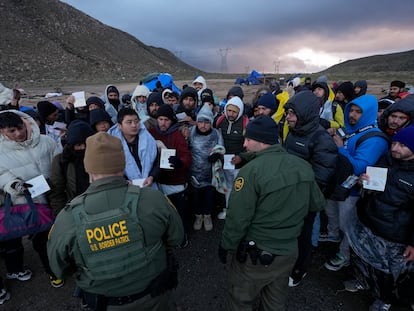Trump deported fewer people than Obama, Clinton or Bush, but more indiscriminately
Biden is nearing the 1.5 million deportations carried out by his predecessor but has focused more on returns at the border and the deportation of migrants with criminal convictions


Although Donald Trump has positioned himself as the biggest champion for deportations, pledging to oversee the largest deportation operation of migrants in U.S. history, as president, he expelled fewer people than his predecessors. Between 2017 and 2021, his administration conducted 1.5 million deportations. In comparison, during Barack Obama’s presidency from 2009 to 2017, there were five million deportations, while George W. Bush’s tenure saw 10 million, and Bill Clinton’s administration reached 12 million. However, these numbers span two presidential terms, while Trump’s figure is for a single term.
President Joe Biden has also nearly matched Trump’s deportation figures. According to data from the Department of Homeland Security (DHS), as of September this year, 1.4 million deportations had been recorded (excluding administrative returns, when individuals voluntarily withdraw their asylum applications). This figure also does not include expulsions under Title 42, which mandated the return of migrants to Mexico while they awaited court dates for asylum requests. Although Title 42 originated under Trump, the majority of the three million resulting expulsions occurred during Biden’s presidency, before the policy was ended in May 2023.
However, the numbers alone do not tell the full story; there are significant differences in the approach taken by each administration. Under Biden, most deportations are classified as “returns,” as described by DHS. They are carried out at the border, much like during the Bush and Clinton administrations. During Clinton’s two terms, 11.4 million of the 12.3 million total deportations (93%) were returns, a figure that includes both law enforcement and voluntary administrative returns. Under Bush, 8.3 million out of 10.3 million total deportations (81%) were returns, predominantly involving migrants from Mexico.
“The Biden administration’s approach is similar to that of Clinton and Bush in that they emphasize rapid returns at the U.S.-Mexico border, but the difference is that the majority of arrivals under Clinton and Bush were single Mexican men, whereas now the picture is much more complex, with families and children arriving from all over the world,” said Kathleen Bush-Joseph, an analyst at the Migration Policy Institute (MPI).
Until Obama’s presidency, most migrants apprehended at the southwest border were allowed to voluntarily return or withdraw their application for admission rather than face formal deportation. This changed under Obama, where interior deportations began to outnumber border returns, a trend that continued under Trump, though with distinct differences.
Anyone ‘deportable’
Under Obama, the policy focused on deporting individuals convicted of crimes. Bush-Joseph points out that “Trump didn’t have those priorities in place, so they simply deported people who were deportable,” including those who had entered the U.S. illegally. This policy involved widespread family separations and the detention of thousands of children.
Concerns about a recurrence of such measures have intensified with Trump’s recent appointments for immigration policy. Tom Homan, the new “border czar,” and Stephen Miller, who has been picked for White House deputy chief of staff for policy, were architects of the family separation policy. Homan has already warned that he intends to deport entire families.
Biden reinstated Obama’s criteria, prioritizing the expulsion of individuals who pose a threat to national security or public safety, or who recently crossed the border. During Biden’s tenure, there was a dramatic surge in the number of undocumented migrants attempting to enter the U.S. From fiscal year 2021 through February 2024, authorities reported 9.4 million encounters, more than triple the number seen under Trump (though this includes many repeat attempts).
Historically, most deportations were to Mexico and northern Central America, but by 2023, deportations to over 170 countries, including nations in Africa and Asia. This was facilitated by negotiations with countries that had been resistant to receive deportees, such as China, Cuba, and Venezuela.
To address the crisis, Biden approved a restrictive asylum law in June, closing the border if weekly crossings exceeded 2,500. Although this measure reduced irregular entries to four-year lows, the threshold was later lowered to 1,500 crossings in 28 consecutive days.
If Trump, as he reiterated on Monday, aims to carry out the largest deportation operation in U.S. history, he will face logistical and budgetary challenges. To address these issues, the Biden administration sought bipartisan approval for a $19 billion funding package to enhance personnel, facilities, and repatriation resources. However, Trump blocked this proposal, not wanting the Democrats to score a legislative goal ahead of the presidential election. Whether Trump will succeed in fulfilling his promise remains to be seen, but he has declared his willingness to invest whatever it takes to make it happen.
Sign up for our weekly newsletter to get more English-language news coverage from EL PAÍS USA Edition
Tu suscripción se está usando en otro dispositivo
¿Quieres añadir otro usuario a tu suscripción?
Si continúas leyendo en este dispositivo, no se podrá leer en el otro.
FlechaTu suscripción se está usando en otro dispositivo y solo puedes acceder a EL PAÍS desde un dispositivo a la vez.
Si quieres compartir tu cuenta, cambia tu suscripción a la modalidad Premium, así podrás añadir otro usuario. Cada uno accederá con su propia cuenta de email, lo que os permitirá personalizar vuestra experiencia en EL PAÍS.
¿Tienes una suscripción de empresa? Accede aquí para contratar más cuentas.
En el caso de no saber quién está usando tu cuenta, te recomendamos cambiar tu contraseña aquí.
Si decides continuar compartiendo tu cuenta, este mensaje se mostrará en tu dispositivo y en el de la otra persona que está usando tu cuenta de forma indefinida, afectando a tu experiencia de lectura. Puedes consultar aquí los términos y condiciones de la suscripción digital.
More information
Archived In
Últimas noticias
Maduro pleads not guilty before the federal court in New York: ‘I am still the president of Venezuela’
A new test can detect Alzheimer’s from a finger prick
UN team enters Sudanese city of El Fasher after paramilitary massacre: ‘It’s like a ghost town’
A recipe for resistance: Indigenous peoples politicize their struggles from the kitchen
Most viewed
- Gilles Lipovetsky: ‘If you want to live better and fall in love, take Prozac, don’t look to philosophy’
- Alain Aspect, Nobel laureate in physics: ‘Einstein was so smart that he would have had to recognize quantum entanglement’
- Alvin Hellerstein, a 92-year-old judge appointed by Bill Clinton, to preside over Maduro’s trial in New York
- Why oil has been at the center of Venezuela-US conflicts for decades
- Maduro’s downfall puts China’s relationship with Venezuela to the test










































